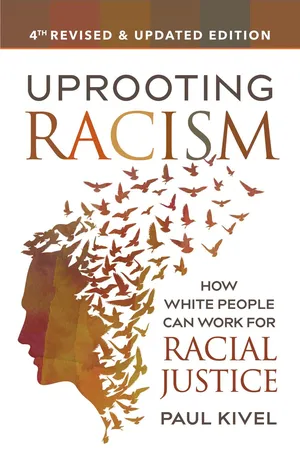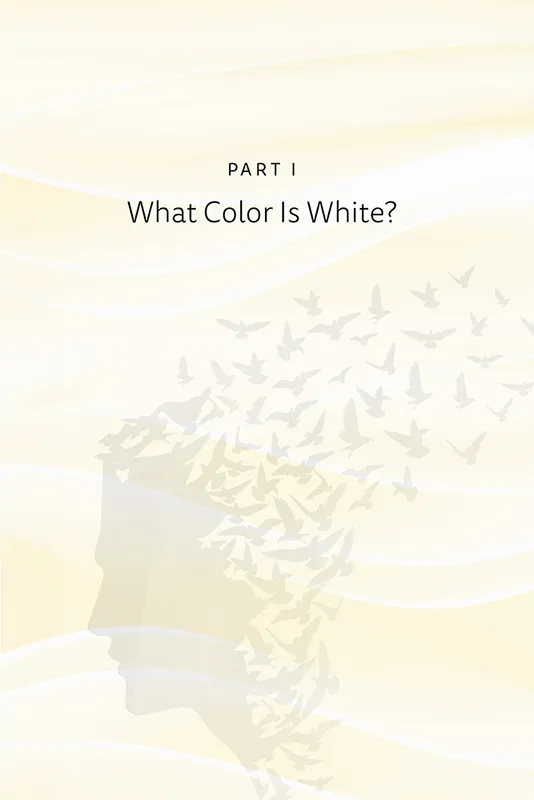![]()
![]()
Let’s Talk
I AM TALKING TO YOU as one white person to another. I am Jewish, and I will talk about that later in this book. You also may have an ethnic identity you are proud of. You likely have a religious background, a culture, a country of origin, and a history. Whatever your other identities, you may not be used to being addressed as white.
Other people are African American, Asian American, Pacific Islanders, Native American, Latinx, or Muslims. Other people have countries of origin and primary languages that are not English. White people generally assume people are white unless otherwise noted, much as humans can assume people and animals are male.
Read the following lines:
• This new sitcom is about a middle-aged, middle-class couple and their three teenage children.
• They won a medal on the Special Olympics swim team.
• He did well in school but was just a typical all-American kid.
• They didn’t know if they would get into the college of their choice.
• My grandmother lived on a farm all her life.
Are all these people white? Read the sentences again and imagine the people referred to are Chinese Americans or Native Americans. How does that change the meanings of these sentences? If you are of Christian background, what happens when you imagine the subjects as Muslim or Jewish?
White people assume we are white without stating it because it is “obvious.” Yet there is something about stating this obvious fact that makes white people feel uneasy, marked. What’s the point of saying “I’m white?”
White people have been led to believe racism is a question of particular acts of discrimination or violence. Calling someone a name, denying someone a job, excluding someone from a neighborhood—that is racism. These certainly are acts of racial discrimination. But what about working in an organization where people of color are paid less, have more menial work or fewer opportunities for advancement? What about shopping in a store where you are treated respectfully, but people of color are followed around or treated with suspicion?
People of color know this racism intimately. They know that where they live, work, and walk; whom they talk with and how; what they read, listen to, or watch on TV—their past experiences and future possibilities are all influenced by racism.
For the next few days, carry your whiteness with you. During the day, in each new situation, remind yourself that you are white. How does it feel? Notice how rarely you see or hear the words white, Caucasian or Euro-American.
• Where is it implied but not stated specifically?
• Who is around you? Are they white or people of color?
What difference does it make?
• Write down what you notice. Discuss it with a friend.
Particularly notice whenever you are somewhere there are only white people.
• How did it come to be that no people of color are present?
• If you ask about their absence, what kinds of explanations/rationalizations do people give?
• Are they really not there, or are they only invisible?
• Did they grow some of the food, originally own the land, build the buildings, or clean and maintain the place where you are?
![]()
“I’m Not White”
I WAS ONCE doing a workshop on racism in which we divided the group into a caucus of people of color and a caucus of white people to elicit more in-depth discussion. Immediately some of the white people said, “But I’m not white.”
I was somewhat taken aback because although these people looked white, they were clearly distressed about being labeled white. A white Christian woman stood up and said, “I’m not really white because I’m not part of the white male power structure that perpetuates racism.” Next a white gay man stood up and said, “You have to be straight to have the privileges of being white.” A white, straight, working-class man from a poor family then said, “I’ve got it just as hard as any person of color.” Finally, a straight, white, middle-class man said, “I’m not white, I’m Italian.”
My African American coworker turned to me and asked, “Where are all the white people who were here just a minute ago?” I replied, “Don’t ask me. I’m not white, I’m Jewish!”
Those of us who are middle-class are more likely to take it for granted that we are white without having to emphasize the point, and to feel guilty when it is noticed or brought up. Those of us who are poor or working-class are more likely to have had to assert our whiteness against the effects of economic discrimination and the presence of other racial groups. Although we share benefits of being white, we don’t share the economic privileges of being middle-class, and so we are more likely to feel angry and less likely to feel guilty than our middle-class counterparts.
In the US it has always been dangerous even to talk about racism. “N***** lover,” “Indian lover,” and “race traitor” are labels that have carried severe consequences for white people. You may know the names of white civil rights workers Goodman, Schwerner, and Luizzo who were killed for their actions. Many of us have been isolated from friends or family because of disagreements over racism. A lot of us have been called “racist.”
I want to begin here—with this denial of our whiteness—because racism keeps people of color in the limelight and makes whiteness invisible. Whiteness is a concept, an ideology, which holds tremendous power over our lives and, in turn, over the lives of people of color. Our challenge as white people will be to keep whiteness center stage. Every time our attention begins to wander off toward people of color or other issues, we must learn to notice and refocus. We must not try to escape our white identity.
• What parts of your identity does it feel like you lose when you say aloud the phrase “I’m white?”
• When they arrived in the North America, what did members of your family have to do to be accepted as white? What did they have to give up?
• Has that identification or pride ever allowed you or your family to tolerate poverty, economic exploitation, or poor living conditions because you could say, “At least we’re not colored?”
I realize there are differences between the streets of New York and Minneapolis, Vancouver, and Winnipeg, and between different neighborhoods within each city. But in US and Canadian society, there is a broad and pervasive division between those of us who are treated as white people and those of us who are treated as people of color. If, when you move down the streets of major cities, other people assume, based on skin color, dress, physical appearance, or total impression that you are white, then in US society that counts for being white.
Several studies have shown that young people between the ages of two and four notice differences of skin color, eye color, hair, dress, and speech and the significance adults give to those differences.1 This is true even if parents are liberal or progressive. The training is too pervasive within our society for anyone to escape. Anthropology and sociology professor Annie Barnes recounts the following interview with a parent who noticed how early in their lives white children learn racism.
I experienced it [racism] through my three-year-old daughter. One day at preschool, the students had a “show and tell.” All the students had brought their toys to school. My daughter forgot her toys, so I had to go home and get them. My daughter told me specifically what to bring. She wanted her pretty black Barbie doll with the white dress. She loved this doll and thought that it was pretty and often said, “When I grow up, I want to look just like my Barbie.”
All the other children were white. While my daughter brought out her Barbie during show and tell, they screwed up their faces and said, “Yuck. That’s not Barbie. She’s ugly.”... She cried for hours and never carried her doll to school again, I couldn’t believe those little children’s actions. That was racism by babies, so to speak.2
Say “I am white” to yourself a couple of tim...









